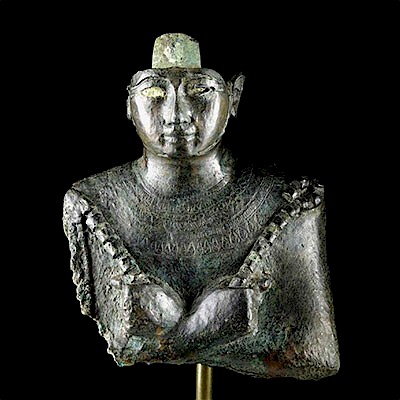Greek 22K+ Gold Diadem Strap - 10.78 g
Lot 37b
About Seller
Artemis Fine Arts
686 S Taylor Ave, Ste 106
Louisville, CO 80027
United States
Selling antiquities, ancient and ethnographic art online since 1993, Artemis Gallery specializes in Classical Antiquities (Egyptian, Greek, Roman, Near Eastern), Asian, Pre-Columbian, African / Tribal / Oceanographic art. Our extensive inventory includes pottery, stone, metal, wood, glass and textil...Read more
Estimate:
$4,000 - $6,000
Absentee vs Live bid
Two ways to bid:
- Leave a max absentee bid and the platform will bid on your behalf up to your maximum bid during the live auction.
- Bid live during the auction and your bids will be submitted real-time to the auctioneer.
Bid Increments
| Price | Bid Increment |
|---|---|
| $0 | $25 |
| $300 | $50 |
| $1,000 | $100 |
| $2,000 | $250 |
| $5,000 | $500 |
| $10,000 | $1,000 |
| $20,000 | $2,500 |
| $50,000 | $5,000 |
| $100,000 | $10,000 |
| $200,000 | $20,000 |
About Auction
By Artemis Fine Arts
May 22, 2019
Set Reminder
2019-05-22 10:00:00
2019-05-22 10:00:00
America/New_York
Bidsquare
Bidsquare : Exceptional Day 1: Antiquities Asian Fine Art
https://www.bidsquare.com/auctions/artemis-gallery/exceptional-day-1-antiquities-asian-fine-art-4129
Day 1 of an important 2-day auction featuring exceptional art from around the world - Egyptian, Greek, Etruscan, Roman, Viking, Russian, Near Eastern; Asian Art from China, Japan, Thailand, Vietnam, Burma, India; Fine Art from the 17th century to present. Artemis Fine Arts info@artemisgallery.com
Day 1 of an important 2-day auction featuring exceptional art from around the world - Egyptian, Greek, Etruscan, Roman, Viking, Russian, Near Eastern; Asian Art from China, Japan, Thailand, Vietnam, Burma, India; Fine Art from the 17th century to present. Artemis Fine Arts info@artemisgallery.com
- Lot Description
Greek, Hellenistic Period, ca. 3rd to 1st century BCE. An incredible example of the beauty and precision of Hellenistic gold work, this is the end of a strap from a diadem, its surface composed of a piece of gold sheet decorated with six bands of woven wires on top and bottom (gold is 92% pure, equivalent to 22K+). Between these are diamonds made of woven wires, with rosettes made of granulations set in their centers. Around the intact, curved end, larger granules form a rounded border. Imagine how this sumptuous item would have looked when worn, pressed against a woman's hair, gleaming in the light of an oil lamp or the sun. Size: 3.75" W x 0.85" H (9.5 cm x 2.2 cm); 1.6" H (4.1 cm) on included custom stand; gold is 92% pure, equivalent to 22K+; total weight: 10.78 grams
The diadem is one of the oldest and most characteristic articles of women's jewelry that originated in the Greek world. While wreaths and coronets were worn by men as signs of social or political status, and as funerary objects, diadem were worn solely by women, usually strictly for decorative purposes. Numerous examples in gold have been found in necropolises in southern Italy, Macedonia, and on the Black Sea coast, testifying to the great refinement of Greek jewelry-making during the Hellenistic period, and to the widespread diffusion of decorative motifs throughout the Mediterranean basin.
Provenance: private New York, New York, USA collection; ex-Shlomo Moussaieff collection, Israel, formed 1948 to 2000, exported with the permit of the Israeli Antiquities Authority
All items legal to buy/sell under U.S. Statute covering cultural patrimony Code 2600, CHAPTER 14, and are guaranteed to be as described or your money back.
A Certificate of Authenticity will accompany all winning bids.
We ship worldwide and handle all shipping in-house for your convenience.
#146343Piece is a fragment as shown, with loss from one end. Form is slightly bent. The granulation that remains is in beautiful condition.Condition
- Shipping Info
-
All shipping is handled in-house for your convenience. Your invoice from Artemis Gallery will include shipping calculation instructions. If in doubt, please inquire BEFORE bidding for estimated shipping costs for individual items.
-
- Buyer's Premium



 EUR
EUR CAD
CAD AUD
AUD GBP
GBP MXN
MXN HKD
HKD CNY
CNY MYR
MYR SEK
SEK SGD
SGD CHF
CHF THB
THB














